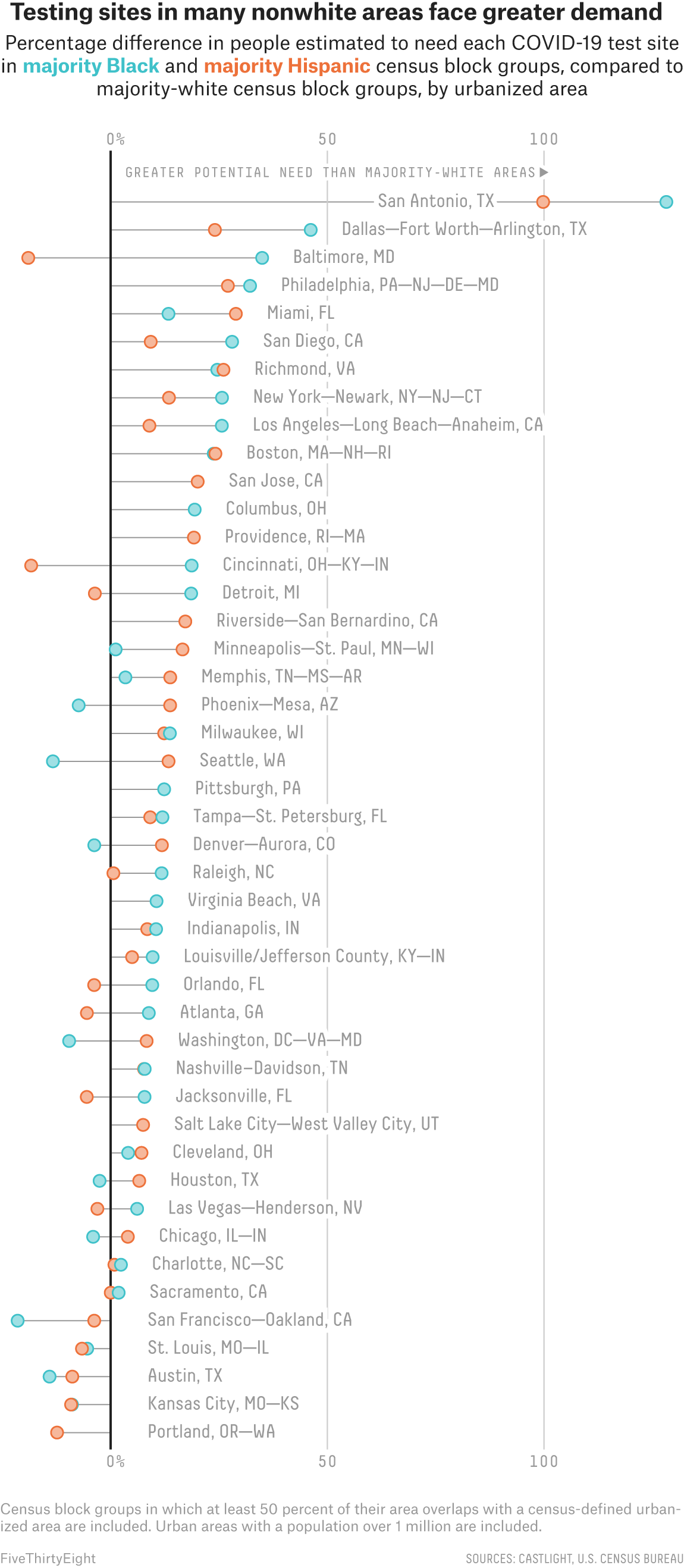7 On Your Side Investigates: Testing centers in many non-white neighborhoods likely to be more crowded

NEW YORK (WABC) -- Health experts have repeatedly said early detection of COVID-19 is key to preventing the virus' spread, but new analysis by the 7 On Your Side Investigates data team, ABC News and FiveThirtyEight found where Americans live and how much money they earn has impacted their access to tests in major cities from coast to coast.
The New York Metro Area ranked among the top 10 major US cities with testing disparities, behind other cities such as Philadelphia, Miami and Dallas.
In New York City specifically, we looked at nearly 400 testing sites active through at least June 18 and found predominantly black and Latino communities were likely to face testing sites up to 26% busier than testing sites in communities with a greater percentage of white residents.
We found a greater concentration of testing sites per capita in wealthier areas of Manhattan reducing the likelihood of long waits for tests, compared to certain predominantly minority communities in parts of Queens, Brooklyn and the Bronx.
We determined the potential demand for each testing site based on Census data indicating the population of people in the immediately surrounding neighborhoods, assuming people would obtain coronavirus tests at facilities nearest their homes.
We also explored the demographics of those neighborhoods to understand what groups would be more likely to experience busier test centers.
The findings are estimates and predictions. The analysis does not consider every factor that could impact testing capacity. We could not account for differences in site staffing or eligibility requirements to obtain a test.
Secondarily, we looked at coronavirus test results by zip code provided by the New York City Department of Health. That data revealed that several of the same neighborhoods in which our analysis found residents would be more likely to experience busy test centers, also saw fewer individuals obtaining tests but higher coronavirus positivity rates among individuals who did get tested.

"These disparities didn't just materialize out of thin air," said Elisabeth Benjamin, vice president of Health Initiatives for the Community Service Society of NY, an organization that works to end inequalities in healthcare access and resources. "These disparities occurred by design and that is what we call structural racism."
Benjamin said the same policies that have contributed to fewer hospitals beds for residents in low-income and minority communities and poorer outcomes for individuals in those communities who acquired coronavirus, are to blame for disparities in testing sites.
"There is no biologic or genetic reason for communities of color to be disparately impacted by the pandemic," Benjamin said. "What is true is that communities of color have less access to healthcare resources. We and New York State really have to do some soul searching about how we allocate our resources."
WATCH | Extended interview with Elisabeth Benjamin

New York City Health Commissioner Dr. Oxiris Barbot also addressed the disparities in individuals obtaining coronavirus tests during a July press conference in the Bronx, unveiling a new mobile testing site targeting one neighborhood of the Bronx where fewer people were getting tested for the virus.
"When you have low testing but high positivity, that high hit-rate indicates we need to test more people," Dr. Barbot said. "We need to make it easy as possible for people to get tested."
The new testing site Dr. Barbot spoke from in the Tremont area is part of a new hyper local effort announced by Mayor Bill de Blasio to increase testing in communities hardest hit by the coronavirus.
"The best thing we can do is go in and really try to promote testing within the community, with community organizations," said Dr. Ted Long, who oversees the city's test and trace efforts. "We plan to keep doing this in a variety of different communities."
Benjamin called the city's pop-up testing sites a step toward progress but she is also calling for statewide policy changes to divert healthcare resources to the communities who need it most.
Her organization is calling for safety net hospitals to be protected from any potential Medicaid cuts following the pandemic. She is also calling on New York to commit a greater percentage of healthcare funding to hospitals in low-income communities that serve a higher rate of Medicaid patients.
For patients, Benjamin's group is calling for a moratorium on collecting medical debt and also an extension on deadlines to pay premiums for health insurance policies so that people do not lose coverage during the pandemic.
Contributing: The nationwide data analysis and additional reporting for this story was contributed by a team, including Soo Rin Kim and Matthew Vann of ABC News, Laura Bronner of FiveThirtyEight and Grace Manthey of ABC Owned Television Stations. The full analysis is here and an explanation of how we did it can be found here.
Up to 4,000 coronavirus cases prevented by NYC contact tracers

MORE CORONAVIRUS COVID-19 COVERAGE
abc7NY Phase Tracker:
COVID-19 Help, Information. Stimulus and Business Updates
UPDATES
7 On Your Side Investigates: Up to 4,000 coronavirus cases prevented by NYC contact tracers

REOPENING INFORMATION
Total count of NYC, Long Island COVID-19 cases based on patient address











